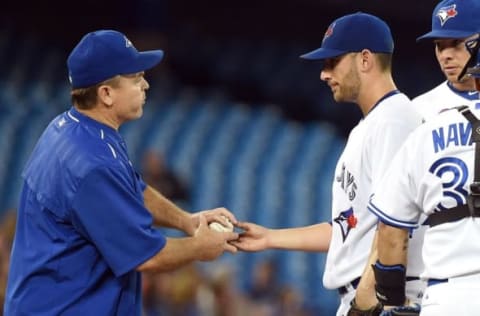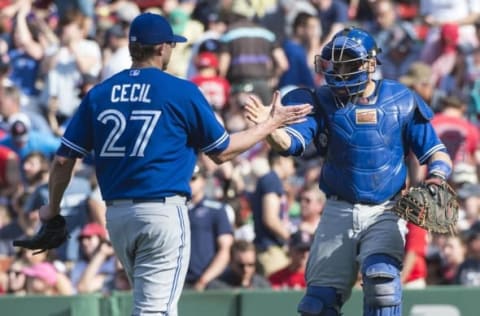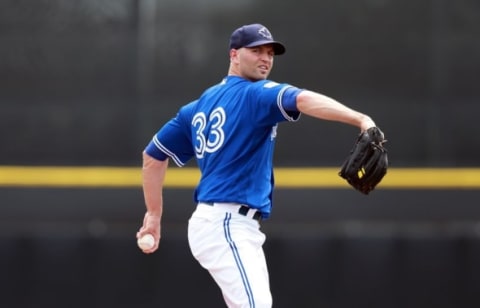Blue Jays season preview: Three reasons it could go wrong


The Toronto Blue Jays enter 2016 as legitimate World Series contenders, but they’ll need to avoid these three traps along the way
On Sunday afternoon in Tampa, Chris Archer will kick and deal to Kevin Pillar and we’ll finally put five months of hypotheticals to rest.
Until then, here is part one of your 2016 Toronto Blue Jays season preview.
The Blue Jays jolted a nation awake in 2015 with a playoff run that ended just short of the World Series stage. Fans will have some new names and faces to familiarize themselves with this season, but in comparison to recent winters, the Blue Jays’ core remains relatively intact.
For all the optimism surrounding this team, we unfortunately cannot ignore the challenges that await the Blue Jays over these next six months. (Tomorrow we’ll look at five reasons the 2016 season could all go right for the Blue Jays. It’s a greater number than these three reasons for worry, as sensationalizing these for the sake of even numbers benefits neither your or I).
In season’s past, the Blue Jays have fallen victim to the most common stumbling block in baseball: depth. While the Bostons and New Yorks of the world were able to trot out MLB-calibre players from their bench and triple-A squads, the Blue Jays often could not keep pace. Instead, fans were greeted with a steady stream of names that sent them a-Googling.
Now, Toronto enters a season with last year’s opening day starter stashed away at triple-A. Not without reason, of course, but the new regime of Mark Shapiro and Ross Atkins have consciously addressed the Blue Jays depth over the past several months.
In doing this, the Blue Jays have obviously missed out on the sexy names.
No David Price. No repeat of last offseason’s Josh Donaldson trade. Come June and July, however, when the Jays can roll out MLB-level talent with their eighth starter and fifth or sixth outfielder, the strategy will look a little clearer.
So let’s dive in. We’re still a little early in the season to be cynical, so instead of calling these the three reasons it could all go wrong in 2016, let’s call them “three factors to keep an awfully close eye on.”
First up, a focused look at two positions the Blue Jays need to remain healthy at…
Next: No. 3: One arm and one bat that need to stay off the D.L.

No. 3: Injuries to Brett Cecil or Russell Martin
Injuries. If the Blue Jays see their season derailed in 2016, chances are it will have something to do with the talent sitting on the disabled list, but listing “injuries” alone is too simplistic.
Yes, Jose Bautista or Troy Tulowitzki missing time will stretch the Blue Jays very thin, but with suitable depth (especially in the outfield) and a lineup that could still top the Major Leagues with a star bat on the shelf, we need to be a little more specific.
This leads me to two positions where the Blue Jays may not have a “next man up” that instills a great deal of confidence: Catcher and left-handed reliever.
Beginning with Brett Cecil, a seventh-inning reliever may not appear overwhelmingly important, but the 29-year-old has quietly become one of baseball’s top lefties out of the bullpen. With 146 strikeouts over 107.2 innings pitched these past two seasons, he’s also developed into a high-leverage jewel.
Cecil becomes even more important, though, when considering who the Blue Jays current “second lefty” is.
Ryan Tepera. A 28-year-old right-hander with 33.0 career Major League innings.
He’s got the ability and the backing of John Gibbons, but with Aaron Loup injured (and 2015 still fresh in the memory), Toronto’s lefty depth isn’t terribly encouraging. Expect to see switch-pitcher Pat Venditte surface this year, perhaps even the young Chad Girodo, but Cecil’s loss would not be a simple fix.
A more devastating injury, of course, would be one to Russell Martin. As one of the game’s premiere catchers, not only at the dish but behind it, losing Martin for any extended period of time would represent a drop-off in talent that could weigh down the bottom third of Toronto’s roster.
Josh Thole will open the season as the primary backup and work with R.A. Dickey, but unless his offseason swing overhaul brings surprising results, the lefty bat does not have starting value. Tony Sanchez could be tempting as a call-up option, but just like with Cecil, a direct replacement for Martin’s exact skill set is nowhere to be found.
Next up, a challenge facing Toronto’s starting rotation…
Next: No. 2: Quality innings are great, but what about quantity?

No. 2: Depth of starts from the rotation
In 2016, the Jays should not need to worry about R.A. Dickey’s workload. They didn’t need to worry Mark Buehrle‘s last season, or even David Price’s down the stretch.
This year could be a little different.
Beyond Dickey, the Blue Jays opening day rotation features two young arms in Marcus Stroman and Aaron Sanchez. While many are expecting Stroman to pick up the ‘ace’ tag and run with it, his talent isn’t exactly what’s in question here. Instead, the worry is that, come August or September when Stroman passes 140 innings and begins towards 200, his stamina will be tested.
The same goes for Sanchez, whose workload has been a hot discussion topic this week after beating out Gavin Floyd for the fifth job. Sanchez will reportedly be on an innings limit this season, but with his added bulk and offseason training, will he be able to work consistently into the 7th inning and beyond? Will his secondary pitches allow him to?
In the middle stand J.A. Happ and Marco Estrada. Happ, who signed early in free agency on a three-year deal, has always struggled to work deep into games himself. Last season represented a career-high workload for him with just 172.0 innings, and over 31 starts between the Mariners and Pirates, the lanky lefty pitched a full 7.0+ innings just seven times. He never exceeded seven and a third.
Estrada is coming off a career-high workload of his own, just narrowly eclipsing the 200.0 IP plateau including the playoffs after spending much of his career moving between the rotation and bullpen.
Short starts are fine, and frankly, they’re inevitable regardless of the pitcher’s talent. Between Dickey’s starts, however, the Blue Jays do run the risk of stacking two or three short outings on top of one another. Especially if the bullpen sees an injury or two, this could quickly begin to tax the long relievers and high-leverage arms.
Last, but not least, it’s that dirty word beginning with ‘R’…
Next: No. 1: Hello, Regression, my old friend

No. 1: Regression
The Blue Jays don’t have the 2015 season the just had without some players performing above and beyond expectations. Several players bucked aging trends or broke through with numbers they hadn’t posted before, so in 2016, it’s all about maintaining.
Regression is a tricky term, and all too often it’s thrown around lazily at players who are putting up numbers without making “sense”. With a little context though, it’s easy to see that Toronto’s roster boasts a few at-risk names.
Chris Colabello stands above the crowd following a breakout season at age 31, which is enough reason in and of itself to predict some regression. The main arguing point with Colabello is his 2015 BABIP of .411.
There’s unordinary, there’s absurd, and then there’s Colabello’s 2015 BABIP.
Fangraphs’ STEAMER projections are forecasting that to drop to .322 this season, bringing his average down from .321 to .257 and hurting his power along the way. Some regression here is inevitable, but as long as Colabello can avoid letting it drop that far (which I see being very doable), he’ll be able to give the Jays exactly what they need.
Next: The top-10 Blue Jays catchers of all time
Sticking at first base, Edwin Encarnacion is another candidate. His STEAMER projection of a 2.6 WAR puts him well below the ~4.0 he’s averaged over the past four seasons, and while it’s difficult to accept that as a Jays fan who watches him day in and day out, a regression at this age would fit in with historical trends at the position.
Encarnacion’s simple swing and consistent production in the face of nagging injuries suggests he can ride this wave a little longer, though. Replace “Encarnacion” with “Bautista” in these last few lines, and there’s another case to be made.
Kevin Pillar is another candidate after a breakthrough season of 4.6 WAR, and enters the season with the same 2.6 WAR projection that Encarnacion does.
Even the untouchable Josh Donaldson needs to live up to an MVP-level bar. Regardless of how healthy and productive Donaldson is in his second season with the Blue Jays, that 8.7 WAR from 2015 is a rare, rare accomplishment.
Stay tuned tomorrow for a more optimistic take on the season ahead!